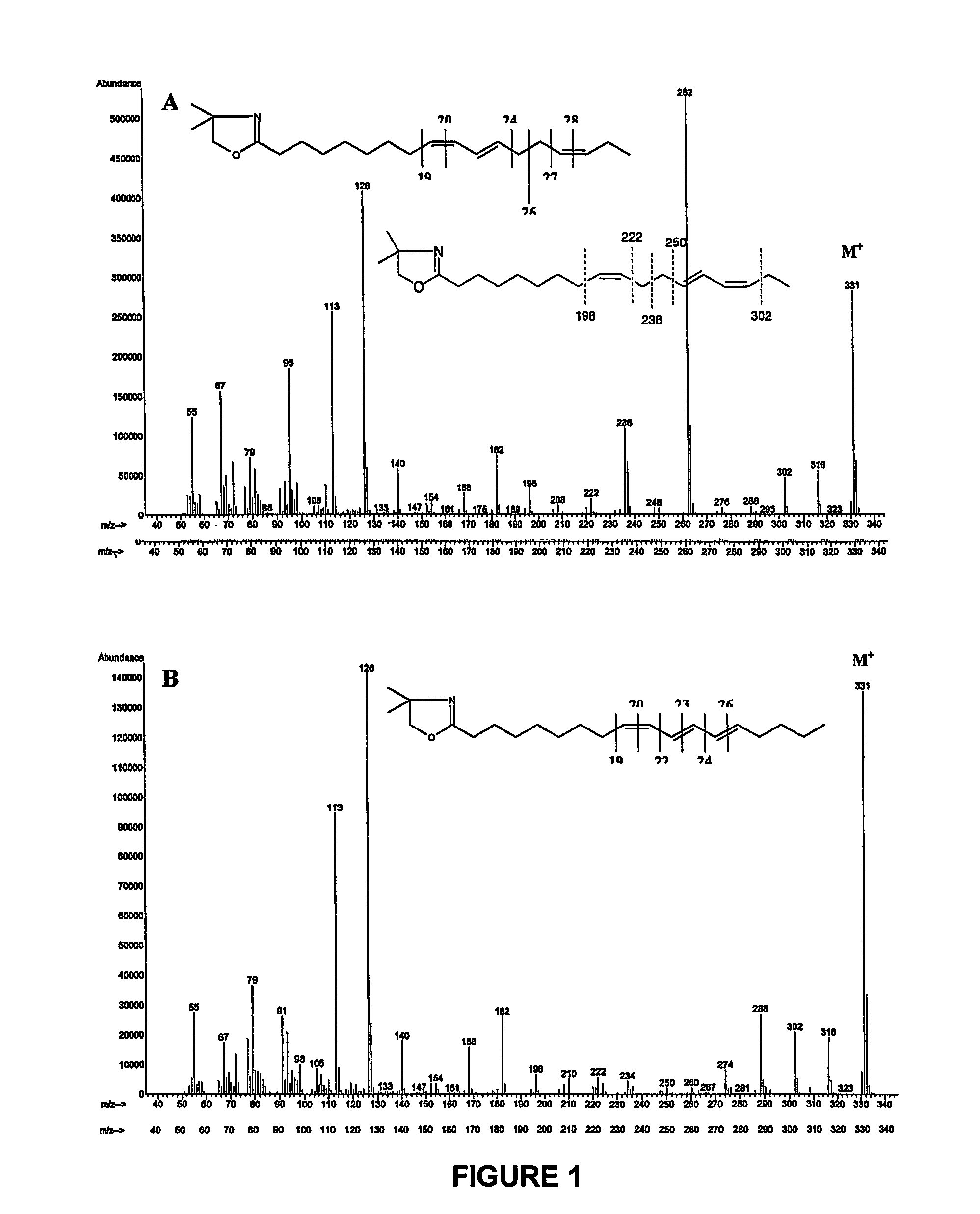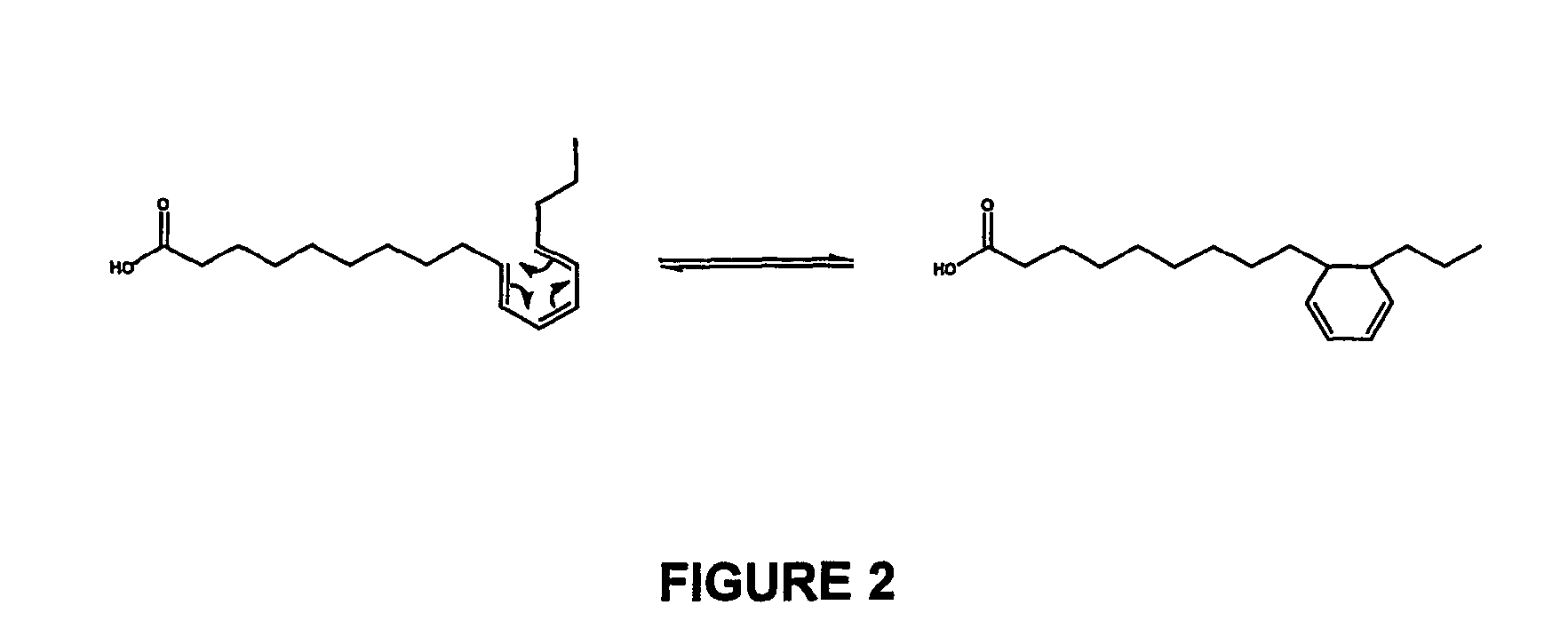Conjugated linolenic acids and methods of preparation and purification and uses thereof
a technology of conjugated linolenic acid and conjugated linolenic acid, which is applied in the field of human and animal nutrition, can solve the problems of limited success in chemotherapeutic treatments, high cost of tung oil for many industrial applications, and limited usefulness of chemotherapeutic treatments available today, and achieves short time period, mild conditions, and high selectivity.
- Summary
- Abstract
- Description
- Claims
- Application Information
AI Technical Summary
Benefits of technology
Problems solved by technology
Method used
Image
Examples
example 2
Linseed Oil Isomerization in Water
[0116]In a preferred embodiment 666 g of NaOH were dissolved in 15.794 kg of water at 80 C in a 25 L stainless steel reactor with a condenser. When dissolution was completed (30 min) 1.428 Kg of linseed oil were loaded under vacuum and nitrogen was use to reestablish the atmospheric pressure. The reaction was performed under nitrogen atmosphere at 170° C. during 3 hours. (Table 9: Assay #2). After what, the mixture was cooled to 60° C. and a stoichiometric amount of CaCl2 was added under very low agitation. The sodium soaps were transformed into calcium soaps and they precipitate while the sodium chloride formed is solubilized in the aqueous phase (FIG. 2). Calcium soaps of isomerized linseed oil were separated by filtration over a centrifuge and washed with water. The washed calcium soaps were transferred to another reactor containing a stoichiometric amount of H2SO4 in methanol. Acidification until pH 3 produces a white precipitate of CaSO4 that w...
example 3
Plukenetia volubilis Oil Isomerization in Water
[0117]In a preferred embodiment 1.22 Kg of NaOH were dissolved in 15.508 Kg of water at 80 C in a 25 L stainless steel reactor with a condenser. When dissolution was completed (30 min) 491 g of Plukenetia volubilis oil were loaded under vacuum and nitrogen was use to reestablish the atmospheric pressure. The reaction was performed under nitrogen atmosphere at 180° C. during 4 hours. (Table 9: Assay #9). After what, the mixture was cooled to 60° C. and a stoichiometric amount of CaCl2 was added under very low agitation. The sodium soaps were transformed into calcium soaps and they precipitate while the sodium chloride formed is solubilized in the aqueous phase (FIG. 2). Calcium soaps of isomerized Plukenetia volubilis oil were separated by filtration over a centrifuge and washed with water. The washed calcium soaps were transferred to another reactor containing a stoichiometric amount of H2SO4 in methanol. Acidification until pH 3 produc...
example 4
Preparation and Purification of 9Z,11E,15Z and 9Z,13E,15Z—C18:3 Acids by Argentation Liquid Chromatography
[0118]Fatty acid methyl esters prepared from products obtained in example 1 and 2 that containing a high level of a mixture of 9Z,11E,15Z and 9Z,13E,15Z—C18:3 were separated using argentation thin layer chromatography. Silica-gel plates were prepared by immersion in a 5% acetonitrile solution of AgNO3 as described by Destaillats et al. (Lipids 35:1027-1032, (2000)). The developing solvent was the mixture n-hexane / diethyl ether (90:10, v / v). At the end of the chromatographic runs, the plates were briefly air-dried, lightly sprayed with a solution of 2′,7′-dichlorofluorescein, and viewed under ultraviolet light (234 nm). The band at Rf=0.52 was scraped off and eluted several times with diethyl ether. Complete evaporation of the combined extracts was achieved with a light stream of dry nitrogen. The residues were dissolved in an appropriate volume of n-hexane and analysed by gas-li...
PUM
| Property | Measurement | Unit |
|---|---|---|
| temperature | aaaaa | aaaaa |
| temperature | aaaaa | aaaaa |
| pH | aaaaa | aaaaa |
Abstract
Description
Claims
Application Information
 Login to View More
Login to View More - R&D
- Intellectual Property
- Life Sciences
- Materials
- Tech Scout
- Unparalleled Data Quality
- Higher Quality Content
- 60% Fewer Hallucinations
Browse by: Latest US Patents, China's latest patents, Technical Efficacy Thesaurus, Application Domain, Technology Topic, Popular Technical Reports.
© 2025 PatSnap. All rights reserved.Legal|Privacy policy|Modern Slavery Act Transparency Statement|Sitemap|About US| Contact US: help@patsnap.com



